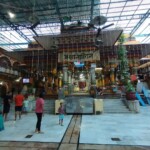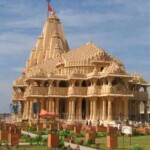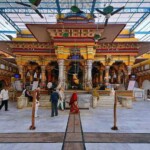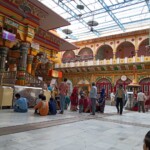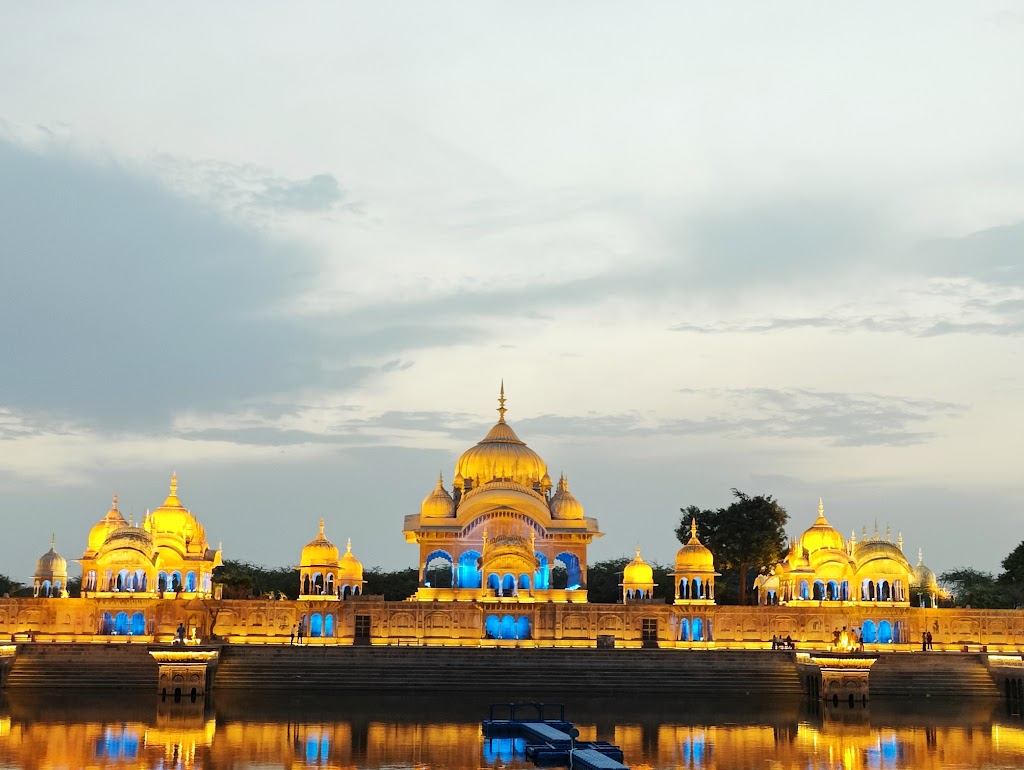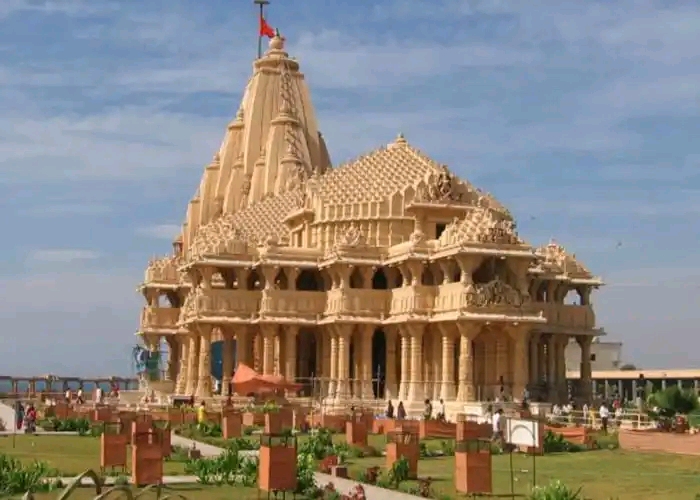
Dwarkadhish Temple, Mathura
The Dwarkadhish Temple in Mathura is one of the most revered and significant Hindu temples dedicated to Lord Krishna. Situated on the banks of the Yamuna River, this temple holds immense religious and historical importance.
The temple’s architecture is a splendid example of North Indian temple style, with intricate carvings, ornate pillars, and a grand entrance. It is believed to have been constructed around 1815 by Seth Gokul Das Parikh, a wealthy merchant.
The main deity worshipped in the temple is Lord Dwarkadhish, another name for Lord Krishna. The idol of Lord Krishna stands in a mesmerizing pose, adorned with rich jewelry and garments. Devotees throng to the temple to seek blessings and offer their prayers.
The temple complex also houses several other shrines dedicated to different deities, including Radha-Krishna, Rukmini, and Balarama. It exudes a divine aura, providing a serene and peaceful atmosphere for devotees to connect with the divine.
Apart from its spiritual significance, the Dwarkadhish Temple holds cultural and historical importance. It is believed to be the birthplace of Lord Krishna, making it a significant pilgrimage site for Krishna devotees.
Visitors can witness the captivating aarti (devotional ritual) performed at the temple, which creates a spiritual ambiance and fills the air with devotional chants and music. The temple also hosts various festivals and celebrations throughout the year, attracting a large number of devotees and tourists.
To visit the Dwarkadhish Temple, Mathura, one can follow the temple’s timings and plan their visit accordingly. The temple is open for darshan (worship) during specific hours, allowing devotees to offer their prayers and seek blessings.
The temple’s location on the banks of the Yamuna River adds to its charm, providing a picturesque backdrop for devotees and tourists. The serene atmosphere and the divine presence make it a must-visit destination for those seeking spiritual solace and a deeper connection with Lord Krishna.
For more information and inquiries, you can contact the temple authorities at the provided phone number. Immerse yourself in the enchanting aura of the Dwarkadhish Temple and experience the divine grace of Lord Krishna.
History of Dwarkadhish temple, Mathura
The Dwarkadhish Temple in Mathura has a history dating back to the early 19th century. It was constructed by Seth Gokul Das Parikh in 1815 as a grand shrine dedicated to Lord Krishna. The temple showcases North Indian architectural style with intricate carvings and sculptures. The main deity is Lord Dwarkadhish (Krishna). The temple attracts devotees from around the world and hosts daily aarti and festivities. It holds immense religious and cultural significance as the birthplace of Lord Krishna and a symbol of devotion and faith in Mathura.
Dwarkadhish temple Located?
The Dwarkadhish Temple is located in the city of Mathura, Uttar Pradesh, India. It is situated in the heart of the city and is easily accessible by road. The temple is a prominent landmark and a popular pilgrimage site for devotees of Lord Krishna.
Dwarkadhish Temple Mathura Image Gallery
The Dwarkadhish Temple in Mathura showcases exquisite architectural brilliance. It follows the traditional North Indian temple architecture style, characterized by intricate carvings, ornate domes, and beautiful sculptures. The temple is constructed with sandstone and features a multi-tiered spire that adds to its grandeur.
The main entrance of the temple, known as the Swarg Dwar, is adorned with intricate carvings depicting various mythological scenes. The sanctum sanctorum houses the idol of Lord Krishna in a standing posture, captivating devotees with its divine beauty.
The temple complex also comprises several other smaller shrines dedicated to various deities and saints. The walls are embellished with intricate motifs, floral patterns, and scenes from Lord Krishna’s life, creating a visually stunning ambience.
The architecture of the Dwarkadhish Temple seamlessly blends spirituality and artistry, making it a remarkable place of worship and an architectural marvel in Mathura.
Entry Fee & Timings of Dwarkadhish Temple, Mathura
The Dwarkadhish Temple in Mathura does not charge an entry fee for visitors. The temple is open to devotees and tourists throughout the year. The general timings for darshan (visiting the temple) are from early morning until late evening. However, it is advisable to check the specific timings as they may vary on special occasions and festivals. Visitors are recommended to arrive early to avoid crowds and to participate in the morning and evening aarti (prayer) ceremonies, which are considered particularly auspicious.
Best time to visit Dwarkadhish Temple, Mathura
The best time to visit the Dwarkadhish Temple in Mathura is during the months of October to March. This period offers pleasant weather with mild temperatures, making it comfortable for exploring the temple premises. Additionally, several festivals and religious celebrations take place during this time, adding to the vibrancy and spiritual atmosphere of the temple. It is important to note that Mathura experiences hot and humid summers, so it is advisable to avoid visiting during the peak summer months of April to June.
Festive Celebrations at the Dwarkadhish temple, Mathura
The Dwarkadhish Temple in Mathura is renowned for its vibrant and grand festive celebrations. The temple hosts various festivals throughout the year, attracting devotees from far and wide. Here are some of the festive celebrations you can experience at the Dwarkadhish Temple:
Janmashtami: Janmashtami, the birth anniversary of Lord Krishna, is celebrated with immense joy and enthusiasm at the Dwarkadhish Temple. Elaborate decorations, devotional music, and cultural performances create a festive atmosphere. The temple becomes a hub of devotees who come to witness the midnight birth ceremony (Janmashtami aarti) and participate in the celebrations.
Holi: Holi, the festival of colors, is celebrated with great fervor at the Dwarkadhish Temple. Devotees gather to play with colors and engage in lively music and dance performances. The temple premises witness a riot of colors and joyous celebrations.
Radhashtami: Radhashtami is dedicated to the divine consort of Lord Krishna, Radha. The temple witnesses special prayers, devotional singing, and processions as devotees celebrate the birth anniversary of Radha. The atmosphere is filled with devotion and reverence.
Annakoot: Annakoot, also known as Govardhan Puja, is a significant festival celebrated at the Dwarkadhish Temple. It commemorates Lord Krishna’s act of lifting the Govardhan Hill to protect the villagers from a torrential downpour. Devotees offer a mountain of food (Annakoot) as a symbol of gratitude and devotion to Lord Krishna.
Jhulan Yatra: Jhulan Yatra is a festival that depicts Lord Krishna and Radha sitting on a swing (jhula) and symbolizes their divine love. The temple decorates swings adorned with flowers and devotees take turns swinging the deities. It is a time of joyous celebrations and devotional songs.
These festive celebrations at the Dwarkadhish Temple create a vibrant and spiritual atmosphere, allowing devotees to immerse themselves in the divine love and devotion towards Lord Krishna. Visitors can witness the rich cultural heritage and experience the essence of devotion during these festive occasions.
Vishram Ghat
Vishram Ghat in Mathura is a sacred bathing ghat on the Yamuna River. It is known for its spiritual significance and the evening Aarti ceremony. Visitors can take a holy dip, enjoy boat rides, and explore the temples and shrines. The ghat offers a serene atmosphere for meditation and is a hub of cultural and festive celebrations. It is a must-visit destination for those seeking spiritual solace and a connection with Hindu mythology.
Shringar Aarti
Shringar Aarti is a significant ritual performed at the Dwarkadhish Temple in Mathura. It is a daily prayer ceremony that takes place in the morning and is dedicated to Lord Krishna, the presiding deity of the temple. Here’s a description of the Shringar Aarti:
Preparation: Before the Aarti, the temple priests meticulously clean and decorate the idol of Lord Krishna. They adorn the deity with fresh flower garlands, jewelry, and vibrant attire to enhance the divine appearance.
Lighting of Lamps: As the sun begins to rise, the temple premises are illuminated with the soft glow of oil lamps. The priests light numerous lamps, spreading a warm and sacred ambiance in the temple.
Chanting of Mantras: The priests commence the Aarti by chanting sacred mantras and hymns dedicated to Lord Krishna. The enchanting sound of the mantras resonates in the air, filling the hearts of devotees with devotion and reverence.
Offering of Incense and Flowers: During the Aarti, the priests offer incense sticks, symbolizing the purification of the surroundings. They also present a variety of fresh flowers to the deity as a gesture of love and adoration.
Aarti Ritual: The highlight of the Shringar Aarti is the waving of the Aarti lamp in front of the deity. The priests hold a large brass lamp with multiple wicks soaked in ghee (clarified butter) and move it in a circular motion, accompanied by rhythmic ringing of bells. This gesture signifies offering light and prayers to Lord Krishna.
Devotional Songs: Throughout the Aarti, devotional songs known as Bhajans are sung by the priests and devotees. These melodious hymns praise the glory of Lord Krishna and evoke a deep sense of devotion among the attendees.
Prasad Distribution: At the conclusion of the Shringar Aarti, devotees are offered the blessed prasad, which is usually a sweet or a sacred food item. It is considered auspicious and is believed to carry the blessings of Lord Krishna.
The Shringar Aarti at the Dwarkadhish Temple is a divine and soul-stirring experience. It allows devotees to connect with Lord Krishna on a spiritual level and seek His divine blessings. The serene atmosphere, the aroma of incense, and the melodious chants create a sense of peace and tranquility, making it a cherished moment for all who witness this sacred ritual.
Explore the Cultural Hub
Mathura, the birthplace of Lord Krishna, is not just a religious destination but also a cultural hub that offers a rich and vibrant experience for travelers. The city is steeped in history and mythology, with numerous temples, ashrams, and cultural sites to explore.
Immerse yourself in the traditional music and dance performances that showcase the essence of Braj culture. Witness the colorful folk dances like Raslila and enjoy the soul-stirring bhajans and kirtans that resonate with devotion. The lively streets of Mathura are filled with local markets, where you can indulge in shopping for handicrafts, traditional clothing, and delicious local sweets.
Don’t miss the opportunity to savor the authentic Braj cuisine, known for its delectable flavors and unique preparations. From piping hot kachoris and jalebis to the famous Mathura peda, the local food will tantalize your taste buds.
Mathura also hosts several cultural festivals throughout the year, including Holi, Janmashtami, and Radha Ashtami. These festivals bring the city to life, with grand processions, colorful decorations, and joyful celebrations.
As you explore the cultural hub of Mathura, you will witness the deep-rooted traditions, the warmth of the locals, and the spiritual aura that permeates every corner of the city. It’s a place where devotion, history, and culture merge, offering a unique and enriching experience for every visitor.
How to Reach Dwarkadhish Temple, Mathura
Dwarkadhish Temple in Mathura is well-connected and easily accessible by various modes of transportation. Here’s how you can reach the temple:
By Air:
The nearest airport to Mathura is Agra Airport, located about 60 kilometres away. From the airport, you can hire a taxi or take a bus to reach Mathura.
By Train:
Mathura Junction is a major railway station that is well-connected to various cities across India. Regular trains ply to and from Mathura, making it convenient for travellers to reach the city. From the railway station, you can hire a taxi or take an auto-rickshaw to reach the Dwarkadhish Temple.
By Road:
Mathura is well-connected to major cities in India by road. The city is easily accessible through national highways and state highways. You can either drive your own vehicle or take a bus to reach Mathura. State-run buses and private buses operate regular services to Mathura from nearby cities and towns.
Local Transportation:
Once you reach Mathura, you can easily find auto-rickshaws, cycle-rickshaws, and taxis to travel within the city. These modes of transportation are readily available and can take you to the Dwarkadhish Temple and other attractions in Mathura.
It is advisable to check the local transportation options and timings beforehand to plan your visit to the Dwarkadhish Temple in Mathura conveniently.
The Darshan and Aarti timings of Shri Dwarkadheesh Mandir in Mathura are as follows:
| Summer | |
| Morning | Evening |
| Mangla: 6:30 am to 7:00 am | Utthapan: 4:00 pm to 4:20 pm |
| Shringar: 7:40 am to 7:55 am | Bhog: 4:45 am to 5:05 pm |
| Gwal: 8:25 am to 8:45 am | Aarti: 5:20 pm to 5:40 pm |
| Rajbhog: 10:00 am to 10:30 am | Sayan: 6:30 pm to 7:00 pm |
| Winter | |
| Morning | Evening |
| Mangla: 6:30 am to 7:00 am | Utthapan: 3:30 pm to 3:50 pm |
| Shringar: 7:40 am to 7:55 am | Bhog: 4:20 pm to 4:40 pm |
| Gwal: 8:25 am to 8:40 am | Aarti: 6:00 pm |
| Rajbhog: 10:00 am to 10:30 am | |
Please note that the timings may vary slightly depending on the season and specific days. It is advisable to check with the temple authorities or the official website for any updates or changes in the Aarti timings before planning your visit.
Location Map for Dwarkadhish Temple Mathura



